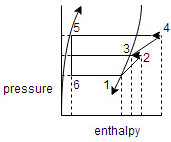This set of Refrigeration Multiple Choice Questions & Answers (MCQs) focuses on “Two/Multi Stage Compression with Liquid Intercooling – 1”.
1. Which one of the following is not an advantage of compound vapor compression with intercooler?
a) It improves the volumetric efficiency for the given pressure ratio
b) It reduces the leakage losses
c) It provides effective lubrication
d) It does not give a uniform torque
View Answer
Explanation: One of the advantages of compound vapor compression with intercooler is that it gives more uniform torque, and hence a smaller size flywheel is needed. Some other advantages are that it improves the volumetric efficiency for the given pressure ratio, it reduces the leakage losses, it provides effective lubrication, etc.
2. What type of compound vapor compression is the following diagram of?

a) Two stage vapor compression with liquid intercooler
b) Three stage vapor compression with liquid intercooler
c) Two stage vapor compression with flash intercooler
d) Three stage vapor compression with flash intercooler
View Answer
Explanation:

The diagram itself shows that it consists of two stage vapor compression with liquid intercooler from the process (1 – 2) and (3 – 4). For three stages there would have been three such processes.
3. Liquid refrigerant is used for inter cooling commonly in multi stage ammonia plants.
a) True
b) False
View Answer
Explanation: Liquid refrigerant is used for inter cooling commonly in multi stage ammonia plants, because of less power requirements due to the fact that the mass of liquid evaporated during intercooling is extremely small because of its latent heat of vaporization and the constant entropy lines of ammonia becomes very flat in the superheat region.
4. Liquid refrigerant is not used for inter cooling in multi stage R- 12 plants.
a) True
b) False
View Answer
Explanation: In case of R – 12 refrigerants, when liquid refrigerant is used for intercooling the total power requirement may increase. It is due to the fact that latent heat of vaporization is small and the constant entropy lines do not change very much with temperature.
5. A compound vapour compression with an intercooler system is used to take 10 TR of refrigeration load (Q). The power required for the refrigerating system P is 550 KW. What is its COP?
a) 0.078
b) 0.086
c) 0.063
d) 0.089
View Answer
Explanation: COP = \(\frac{210×Q}{P×60}\)
COP = \(\frac{210×10}{550×60}\)
= 0.063.
6. Which of the following is not a disadvantage of multiple compressions with intercooling between the stages?
a) Increases the initial cost
b) Size of plant increases
c) Increases the maintenance cost
d) Cylinder wall thickness of low pressure cylinder is increased
View Answer
Explanation: The cylinder wall thickness of low pressure cylinder is reduced, since it is designed to withstand low pressure only. It reduces the cost of the compressor.
7. Why intercooling by liquid refrigerant never used in R-12 systems?
a) High latent heat of vaporization
b) Low latent heat of vaporization
c) Medium latent heat of vaporization
d) High toxicity
View Answer
Explanation: In the case of refrigerant R-12, power requirements may increase. Due to the low latent heat of vaporization and constant entropy lines not getting affected by temperature, the increased mass flow rate of refrigerant through the high-pressure compressor is not compensated by saving in work done close to the saturated vapor line. This might result in a high power requirement and decreasing the C.O.P. Hence, intercooling by the liquid refrigerant in R-12 systems is never employed.
8. The refrigeration effect produced by a system is 10 TR and work done by the low-pressure compressor, and high-pressure compressor is 3 and 4 kW respectively. What is the value of C.O.P. for the given conditions?
a) 8.75
b) 11.67
c) 3.5
d) 5
View Answer
Explanation: Given: R.E. = 10 TR = 10 x 3.5 = 35 kW
Low-pressure compressor work, WL = 3 kW
High-pressure compressor work, WH = 4 kW
C.O.P. = R.E. / Total Work
= R.E. / WL + WH
= 35 / (3 + 4)
= 35 / 7
= 5.
Sanfoundry Global Education & Learning Series – Refrigeration & Air Conditioning.
To practice all areas of Refrigeration & Air Conditioning, here is complete set of 1000+ Multiple Choice Questions and Answers.
If you find a mistake in question / option / answer, kindly take a screenshot and email to [email protected]
- Check Refrigeration & Air Conditioning Books
- Practice Mechanical Engineering MCQs
- Apply for Mechanical Engineering Internship
- Check Mechanical Engineering Books
